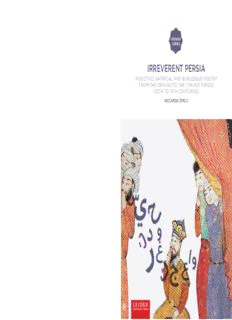Table Of ContentI
r
r
e
IRANIAN v IRANIAN
SERIES e SERIES
r
e
n
t
P
e
r IRREVERENT PERSIA
s
i
Poetry expressing criticism of social, political and cultural life is a vital integral part of a
Persian literary history. Its principal genres – invective, satire and burlesque – have been INVECTIVE, SATIRICAL AND BURLESQUE POETRY
very popular with authors in every age. Despite the rich uninterrupted tradition, such texts FROM THE ORIGINS TO THE TIMURID PERIOD
have been little studied and rarely translated. Their irreverent tones range from subtle
(10TH TO 15TH CENTURIES)
irony to crude direct insults, at times involving the use of outrageous and obscene terms.
This anthology includes both major and minor poets from the origins of Persian poetry RICCARDO ZIPOLI
(10th century) up to the age of Jâmi (15th century), traditionally considered the last great
classical Persian poet. In addition to their historical and linguistic interest, many of these
poems deserve to be read for their technical and aesthetic accomplishments, setting them
among the masterpieces of Persian literature.
Riccardo Zipoli is professor of Persian Language and Literature at Ca’ Foscari University,
Venice, where he also teaches Conceiving and Producing Photography.
The western cliché about Persian poetry is that it deals with roses, nightingales, wine,
hyperbolic love-longing, an awareness of the transience of our existence, and a delicate
appreciation of life’s fleeting pleasures. And so a great deal of it does. But there is another
side to Persian verse, one that is satirical, sardonic, often obscene, one that delights in ad
hominem invective and no-holds barred diatribes. Perhaps surprisingly enough for the
uninitiated reader it is frequently the same poets who write both kinds of verse. Riccardo
Zipoli’s Irreverent Persia is a splendidly comprehensive introduction to this fascinating and
hitherto virtually ignored side of the Persian literary canon, providing a wealth of examples
of the varieties of the genre in accurate and felicitous translations. − Dick Davis, professor
and Chair of the Near Eastern Languages and Cultures Department, Ohio State University
R
i
c
c
a
r
d
o
Z
i
p
o
l
i
LEIDEN UNIVERSITY PRESS
www.lup.nl L U P
IrreverentPersia
iranianstudiesseries
The Iranian Studies Series publishes high-quality scholarship on various
aspects of Iranian civilisation, covering both contemporary and classical
cultures of the Persian cultural area. The contemporary Persian-speaking
areaincludesIran,Afghanistan,Tajikistan,andCentralAsia,whileclassi-
calsocietiesusingPersianasaliteraryandculturallanguagewerelocatedin
Anatolia,Caucasus,CentralAsiaandtheIndo-Pakistanisubcontinent.The
objectiveoftheseriesistofosterstudiesoftheliterary,historical,religious
andlinguisticproductsinIranianlanguages.Inadditiontoresearchmon-
ographs and reference works, the series publishes English-Persian critical
text-editionsofimportanttexts.Theseriesintendstopublishresourcesand
originalresearchandmakethemaccessibletoawideaudience.
chiefeditor
A.A.Seyed-Gohrab(LeidenUniversity)
advisoryboardofiss
F.Abdullaeva(UniversityofCambridge)
G.R.vandenBerg(LeidenUniversity)
F.deBlois(UniversityofLondon,SOAS)
J.T.P.deBruijn(LeidenUniversity)
D.P.Brookshaw(UniversityofOxford)
N.Chalisova(RussianStateUniversityofMoscow)
A.Adib-Moghaddam(UniversityofLondon,SOAS)
D.Davis(OhioStateUniversity)
M.M.Khorrami(NewYorkUniversity)
A.R.KorangyIsfahani(UniversityofVirginia)
F.D.Lewis(UniversityofChicago)
L.Lewisohn(UniversityofExeter)
S.McGlinn(unaffiliated)
Ch.Melville(UniversityofCambridge)
D.Meneghini(UniversityofVenice)
N.Pourjavady(UniversityofTehran)
Ch.vanRuymbeke(UniversityofCambridge)
A.Sedighi(PortlandStateUniversity)
S.Sharma(BostonUniversity)
K.Talattof(UniversityofArizona)
Z.Vesel(CNRS,Paris)
M.J.Yahaghi(FerdowsiUniversityofMashhad)
R.Zipoli(UniversityofVenice)
irreverent persia
invective, satirical and burlesque poetry
from the origins to the timurid period
(10th to 15th centuries)
RiccardoZipoli
LeidenUniversityPress
Coverdesign:TarekAtrissiDesign
Cover illustration: Nizami’s Khamsa. Shiraz, 1449–1450, New York, Metropolitan
MuseumofArt,13.228.2,fol.332r(GiftofAlexanderSmithCochran,1913).
Lay-out:TATZetwerk,Utrecht
isbn 9789087282271
e-isbn 9789400602120(ePDF)
e-isbn 9789400602137(ePub)
nur 635
©RiccardoZipoli/LeidenUniversityPress,2015
All rights reserved. Without limiting the rights under copyright reserved above, no
partofthisbookmaybereproduced,storedinorintroducedintoaretrievalsystem,
or transmitted, in any form or by any means (electronic, mechanical, photocopying,
recordingorotherwise)withoutthewrittenpermissionofboththecopyrightowner
andtheauthorofthebook.
ThisbookisdistributedinNorthAmericabytheUniversityofChicagoPress
(www.press.uchicago.edu)
Contents
NotesonTransliterationSystem,DatesandBiographicalInformation
Acknowledgements
Introduction
TheGenreofHajv(‘Satire’,‘Mockery’,‘VerbalAggression’)
TheGenreofHazl(‘Witticism’,‘Facetiae’,‘BawdyPoetry’)
HistoricalBackground
PoeticForms
TraditionofStudies
AuthorsandTexts
chapter1–InvectivePoetry
PhysicalImages
ActionsInvolvingtheVictimsofSatire
ImprecatoryPoetry
CompositePoetry
chapter2–SatiricalPoetry
PatronsandRulingClasses
Poets
CourtMilieu
ReligiousContext
WomenasHabitualSubjectforSatire
SatirisingMembersofaFamily
PeoplesandTowns
AddresseeswithnoSocialLabels
BehaviourandCustoms
6 | IrreverentPersia
chapter3–BurlesquePoetry
FormandContent
RepliestoPoems
BiographiesofthePoets
GlossaryofKeyLiteraryTerms
Notes
Bibliography
IndexofNames,PlacesandWorks
Notes on Transliteration System,
Dates and Biographical Information
Except in cases for which there is a widely accepted spelling (such as Bu-
kharaandMuʿâwiya),thePersianandArabictermshavebeentransliterated
followingtherulesproposedbytheLibraryofCongressforPersian,butwith
nodiacriticalmarks:onlythelongvowel‘a’isindicatedasâ(corresponding
toa‘back’a).Forthevowelsandthediphthongs,thetransliterationisbased
onthestandardcontemporaryPersianpronunciation.TheaccentinPersian
nounsfallsonthelastsyllable.
Only the Christian era system of dates has been used with no corre-
spondingIslamicdates.Thisruledoesnotapplytotheyearofpublication
for books cited in the bibliography, in which both dates are included (the
Christiandatefirst).WhenthereisadoubledatefortheChristianera(for
example, 1160/1), this indicates that the corresponding year in the Islamic
erastraddlestwoyearsintheChristianeraanditisnotknowninwhichof
thetwotheeventinquestiontookplace.
Thepoets’namesarewritteninsummarisedform(intheIslamicworld
thenameofapersonofteninvolvesalongseriesofcomponents),butinsuch
awayastomakethemeasilyidentifiable.Incasesofhomonymy,anextra
elementisadded,usuallythenisba(indicationofgenealogical,ethnicalor
geographicalprovenance).
In an appendix at the end of the book there are brief biographical
notes on the poets translated in the anthology. In the introduction all the
namesofpeopleareaccompaniedbyareferencedatethefirsttimetheyare
mentioned.
Therearenonotesforwell-knownplacesorpeople(suchastheprophet
Muhammad)orunknownnames(ashappens,forexample,withsomeper-
sons contemporary to our poets). If a term requiring comment or expla-
nationrecursseveraltimesinthesamepoem,thenoteappearsatthefirst
mentionoftheterm.
The English equivalents of technical terms are provided only the first
timethattheyoccur,butaglossaryofthekeyliterarytermsisprovidedat
theendofthebook.
Acknowledgements
Ibeganthisworkin1993and,fromtheoutset,Iwasluckyenoughtorely
on the invaluable collaboration of my friend and colleague Hamid Rezâ
Bahârlu,whounfortunatelydiedprematurelyandwhomIrememberwith
deepandheart-feltgratitude.Hishelpandintuitiveinsightwerecrucialin
findingandinterpretingthecorpuscollectedhere.
The work came into being at the prompting of Ehsan Yarshater, who
alsoreadthroughapreliminaryversionandofferedadvice.Encouragement
andsuggestionsfromFrançoisdeBlois,HansdeBruijnandGeertJanvan
Gelderwereofvitalimportanceincompletingthework.Lastly,itwasdueto
theinterestshownbyAsgharSeyed-Gohrabthatthisbookeventuallyfound
aprestigiouspublisher.Iofferthemallmywarmestthanks.
Moreover, I should like to express my gratitude to Jalâl Moravvej and
GianrobertoScarciafortheirextremelyexpertcommentsintheinterpreta-
tionofcontroversialpassages,andtoDanieleGuizzoandStefanoPellòwho
provided initial Italian translations of some of the texts. I am also deeply
indebtedtoGianrobertoScarcia,DanielaMeneghini,DanieleGuizzoand
StefanoPellòforreadingandcheckingsomepartsofthebook.
Finally,manythanksgotoDavidKerrforhisessentialcontributionto
draftingthistextinEnglish.
Description:cal societies using Persian as a literary and cultural language were located in. Anatolia that his table is only laid with sausages.102. Maʿrufi.

